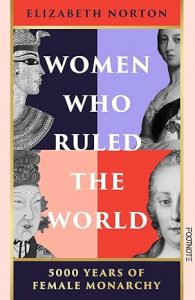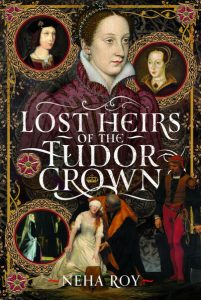I am delighted to host this guest article by Linda Porter.
You can buy it from:
Thank you to Linda for this article.
Margaret, Queen of Scots: the forgotten Tudor
Since my biography of Henry VIII’s elder sister, Margaret, came out in June 2024 I’ve often been asked why I chose to write about her. There are several reasons. One, I’m afraid, is rather prosaic, but it may tell you something about the decisions historians need to make if they want to reach a wider audience – and keep publishing. The simple truth is that I’d had another proposal turned down by my then publisher. I’ll admit I was peeved (this is what happens when a new head honcho arrives and wants to leave their mark on the organisation, it happens everywhere, not just in publishing) and I took a while to think about what to do next. If I’m honest, I would have preferred to stay with the Stuarts rather than go back to the Tudors, but the Tudors still sell more strongly than the Stuarts.
I’d always had a soft spot for Margaret Tudor, an important figure in 16th century British politics, who is generally overlooked. When she is remembered, it is as an over-sexed whinger with a penchant for younger men and an extravagant weakness for clothes and jewels. In other words, Margaret has been dismissed by historians (and not just male historians, female writers have been equally, if not even more, guilty) as a clueless politician and a selfish, shallow woman. Yet I knew that not to be the case, as Margaret was a significant figure in my third book, ‘Crown of Thistles: the fatal inheritance of Mary Queen of Scots’, which came out in 2013. I had a lot of material about her which I hadn’t, for reasons of space, been able to include in that book. So why not try to write a serious but accessible biography of Margaret, which might, hopefully, restore her to her rightful place in Tudor Britain? A brilliant doctoral thesis by linguist Dr Helen Newsome in 2018 had examined in detail much of Margaret’s voluminous correspondence and thrown quite a different light on this much-reviled woman. It seemed like a great opportunity to revisit Margaret and bring her to a wider audience.
So the Margaret Tudor who emerges from the pages of my book, ‘The Thistle and the Rose’, is not an empty-headed clothes horse who likes toy-boys (only one of her three husbands was younger than her, incidentally, and then only by six years) but a determined and courageous woman, certainly not always likeable and definitely not always right, who was committed throughout her life to ensuring that the little son she had late in her marriage to King James IV of Scotland, should survive to attain his majority and rule in his own right. Yes, she knew heartbreak, fear, and, for a queen, considerable financial stress, but she never lost sight of her goal. And did her brother help her? No, he most emphatically did not. In fact, he interfered, hectored, criticised and stood in her way at every possible turn. True, when she fled to England in 1515, afraid for her life in the face of opposition from the duke of Albany, who was regent for her son, James V, Henry supported her in London for a year, but he was keen to send her back to Scotland in the early summer of 1517. By that time he’d decided that her ambitious, unreliable second husband, the earl of Angus, was a better bet to work with than his own sister. As the Angus marriage became more and more embittered and Margaret sought a divorce Henry, with breathtaking hypocrisy, accused her of breaking God’s law and was incredibly critical and hurtful. He was in the early stages of seeking to annul his marriage to Catherine of Aragon at the time. This sibling rivalry, which could have worked out so differently if Henry had been able to bring himself to co-operate effectively with his sister, is an important and under-estimated aspect of Tudor history.
As a girl, Margaret had grown up in the pleasant palaces to the south of London, partly educated with Henry (who was not, of course, the heir for most of their childhoods) and shared tutors with him. The younger children of Henry VII and Elizabeth of York led something of a charmed existence, loved and indulged by both parents. But if Henry was intended for the Church at this time ( it is quite the leap to see him as a future Archbishop or Cardinal), Margaret was always intended for marriage to another royal house. She was, after all, the first Tudor princess. Negotiations for her marriage to James IV of Scotland, a man more than twice her age, began in earnest at the start of the sixteenth century and were concluded in the winter of 1502, not long after her elder brother, Prince Arthur’s marriage to Catherine of Aragon.
Henry VII was keen to put an end to the constant friction on the border with Scotland. James IV had been a thorn in his side on and off throughout the 1490s. As Margaret neared her twelfth birthday, the treaty was concluded. It made provision not just for her dowery and her household as James’s consort, but also for an optimistically named Treaty of Perpetual Peace between the two nations. Margaret made what was perhaps the most splendid progress of the entire 16th century in 1503 when she travelled north to marry James formally in Holyrood Abbey. Passing through all the major English towns of the midlands and north, she was the visible face of the magnificence of her father’s dynasty. The strain this put on a thirteen-year-old girl, who had lost her mother some months before, can only be imagined. But we get a feeling for it in the sad, even desperate letter the exhausted and homesick little Queen of Scots wrote to her father shortly after the wedding, when she said ‘I wish I were with your Grace now and many times more.’
She soon adapted, however, helped by her charismatic and charming husband, one of the great kings of Scotland and a true Renaissance man. Like Margaret, James IV deserves to be much better known but his tragic death at the battle of Flodden in 1513, when he was outmanoeuvred by a smaller English force in a remote corner of Northumberland, cast a pall over Scotland for centuries. Margaret was left a widow at twenty-three. Her toddler son was the only child of six or seven she had with James who survived infancy. There had already been much tragedy in her young life.
Margaret has been heavily criticised for disobeying the terms of James IV’s will and marrying again in the summer of 1514. It is easy to be wise with hindsight but there is no doubt that it was a mistake to marry the young earl of Angus, a man the same age as Margaret, who was himself recently widowed. She had received mixed messages of loyalty from the Scottish lords and she knew that remarriage was a gamble, but she evidently felt it was worth the risk. The general feeling among Scottish historians now is that she was probably pressured into the marriage by Angus’s relations, at a time when she was still recovering from the birth of her last child with James IV, and that it was by no means a love match. She soon found out what sort of man she had married, when he effectively abandoned her and their baby daughter, Lady Margaret Douglas, when Queen Margaret fled to England in the autumn of 1515. Angus’s loyalty was always to himself. It took until 1528 for the divorce she had wanted so long to come through. When it did, she married a third time, to Henry Stewart, a member of her household. She seems, at last, to have been in love. But her third husband was just as greedy and unfaithful as Angus. By the mid-1530s, she wanted to be rid of him, too. Her son, however, had had enough of Margaret’s marital problems and put his foot down.
Margaret was extensively involved in Anglo-Scottish diplomacy for years as a mediator and was an experienced and able practitioner of the various subtleties of diplomatic correspondence. That she was still being used in this way in the 1530s is a tribute to her skill and durability. She was also, interestingly, apparently keen to establish a good relationship with Anne Boleyn. We know they exchanged gifts. Margaret was ever the pragmatist, even if she did not always make the right decisions. In the last years of her life she was often at the Scottish court and her last great gift to her son came not long before her own death. In the summer of 1541 James V and his second wife, Marie de Guise (who had got on well with her mother-in-law), lost both their young sons in the space of two days. Devastated, they turned to Margaret for comfort and she did her best to support them. Perhaps it was all too much for her. In the autumn of 1541 she had a stroke at her castle of Methven, outside Perth. She sent for James V but he was too far away to reach her before she died. He did, though, observe mourning for an appropriate period and gave his mother a splendid funeral.
The English court did not go into mourning and Henry’s only interest was to send a messenger to Scotland to enquire whether his sister had made a will. She had not. But his spite against Margaret lasted even after his death, when he removed all her descendants from the line of the English succession in his own will. Margaret, of course, had the last laugh. The terms of Henry’s will were ignored in 1603, when Elizabeth I died childless. For all the hype about Henry and his six wives and the glorifying of Elizabeth I, we should remember that it is Margaret Tudor’s descendants who sit on the British throne to this day.
Follow Linda on Social Media:
Linda’s website: Linda Porter
Twitter/X: Linda Porter







































